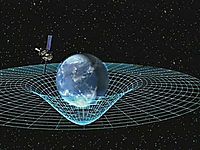
Photo from wikipedia
The ability to mentally rotate objects in space is a fundamental cognitive capacity. Previous studies showed that the time to rotate the image of a figure to match another increases… Click to show full abstract
The ability to mentally rotate objects in space is a fundamental cognitive capacity. Previous studies showed that the time to rotate the image of a figure to match another increases progressively with angular disparity. It remains unclear whether this increase in response time with angular disparity could reflect increased processing operations or more cognitive effort instead of a sustained use of a 'rotate' mechanism without a change in workload. We collected response times as well as pupillary responses that index cognitive workload and activity in the brainstem's locus coeruleus, from a sample of 38 young adults performing a chronometric mental rotations task. The results showed the expected increase in response times but no increase in pupil diameters between 60, 120, and 180 degrees of rotation, suggesting no significant changes in arousal levels when rotating figures near and far. This indicates that during mental rotation the load on cognitive resources remains constant irrespective of angular distance.
Journal Title: Brain and Cognition
Year Published: 2021
Link to full text (if available)
Share on Social Media: Sign Up to like & get
recommendations!